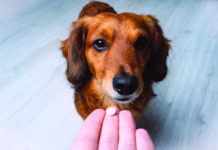Fleas are prolific, producing thousands of eggs during their three- to four-month lifespan. In ideal conditions, the cycle takes just two weeks from egg-laying (the female can lay as many as fifty eggs in a single day and starts laying eggs within a day of landing on your dog) to larvae to pupae to hatched fleas capable of laying eggs of their own. And, fleas can live from twelve days to six months.
Depending on where you live, flea season can be a year-round problem or limited to four or so months annually. They thrive in warm, humid weather. The U.S. Food and Drug Administration estimates there are more than two hundred species of fleas in this country. The American Veterinary Medicine Association estimates that flea-related disease account for 35 percent of visits to all small animal veterinary practices and 50 percent of all skin problems veterinarians see.
The best way to fight fleas is to protect your dog before an infestation, and that doesn’t mean a flea collar.
“In general, the efficacy of flea collars is very low,” says Gene Nesbitt, a clinical professor at Tufts University School of Veterinary Medicine. Topical “spot on” preventatives are much better at battling fleas, effective more than 95 percent of the time. If your dog swims every day, the efficacy of even an excellent topical preventative will be lower.
If you’ve been following an effective flea control program and your dog still becomes infested, that’s a sign that there’s been a break in your program, such as a change in environment, Dr. Nesbitt says.
The Signs
Fleas, often the size of a sesame seed, can be difficult if not impossible to spot. Often, all you’lll see is their dark droppings left on the dog’s coat. Just because you don’t see fleas leaping from your dog when he or she is combed does not mean the animal doesn’t have fleas.
Other signs can include bumps on the dog’s groin and abdomen; hair loss; and crusting and scabbing of sores, particularly in the lumbar region of the animal’s back.
The Treatment
If you or your vet have established that your dog has fleas, Dr. Nesbitt recommends Novartis’ Capstar, given orally in tablet form, to get rid of the insects. “There’s a quick knockdown; in an hour, 90 percent of the fleas will be off, but there is not residual effect,” he says. That means that if you don’t rid the environment of fleas, they’ll be right back on your dog.
“The best solution is a good flea bath and initiation of a permanent, continuous flea control program,” Dr. Nesbitt says. He stresses the importance of treating all animals in the household, even those who don’t show signs of fleas. Otherwise, the insects can lay eggs deep in carpets and rugs, in pet and pet owner’s beds, and elsewhere in the house, resulting in a vicious circle of infestation.
It’s important to give those areas of your home a thorough cleaning as well. Vacuum carpets and rugs frequently, and vacuum or wash your pet’s bedding regularly. Change vacuum bags frequently and burn the used one if there’s been a recent infestation.
To learn more on the best way to prevent and fight bug problems for your dog, purchase Dog Care & Nutrition from Tufts Good Dog Library of Your Dog today.




